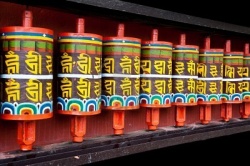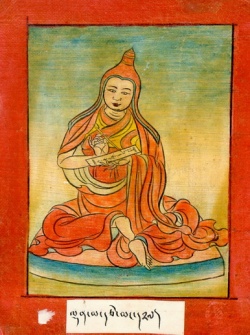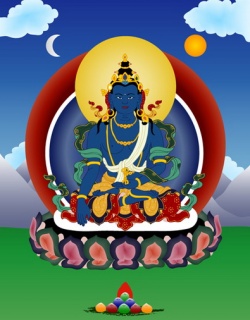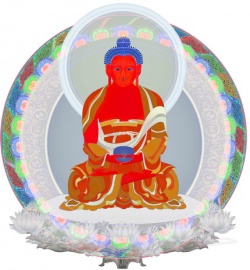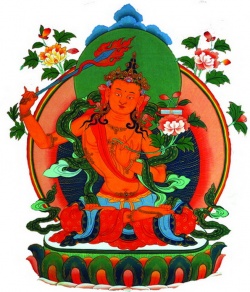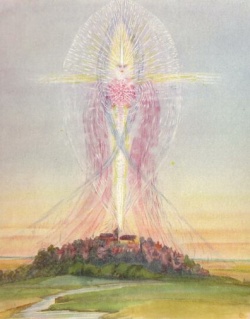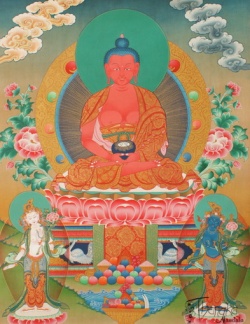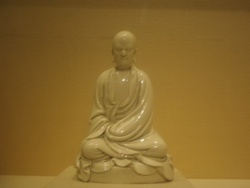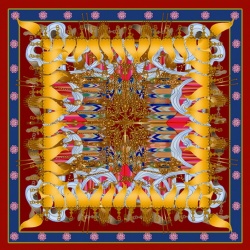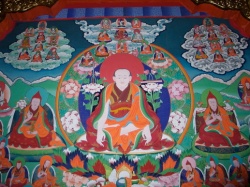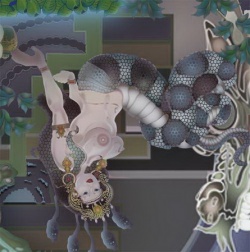Time-wheel
Kalachakra literally means "Time-Wheel". The phrase "as outside, so within" or "as above, so below" is often found in Kalchakra tantra. It emphasizes the relationship of the outer universe with the inner physical and mental processes of humans, describing the concurrence of human and cosmic phenomena with time, and it also builds a complete system of Indian astology.
Among the other practices of the Highest Yoga Tantra (Anuttarayoga अनुत्तरयोग), the Kalachakra is in many aspects somewhat unusual. Many details in this system deviate from the other Buddhist tantras, but they are often also complementary to the other tantric systems. In fact, when the Kalachakra was first introduced in the great Buddhist university of Nalanda (India), these differences did cause some confusion. After extensive study, the greatest masters agreed the system was genuinely Buddhist, and the Kalachakra received its own place in the vast array of Mahayana Buddhist teachings. In many aspects, the Kalachakra system clearly shows its Buddhist core with concepts like renunciation, bodhicitta, emptiness, enlightenment etc. being of major importance to the practice. Kalachakra is also called the "clear" tantra, because its language is unusually clear and straightforward as compared to most other Highest Yoga Tantras.
The Kalachakra teaching as taught by Shakyamuni Buddha is called the Root Kalachakra Tantra, the Kalachakra Mulatantra or Paramadibuddhatantra of 12,000 lines. The Shambhala King Suchandra wrote a commentary called the Explanatory Tantra in 60,000 lines. However, both these texts never reached us.Some parts of the original Paramadibuddhatantra have been preserved by citation in other texts; mainly 200 verses in the Vimalaprabha, and in the Sekoddesa, which circulated as an independent text in early eleventh-century India and has traditionally been considered to be a part of the Paramadibuddhatantra. According to tradition, the Shambhala King Manjushri-Yashas composed the Abridged Kalachakra Tantra or Kalachakra Laghutantra, it is also called 'the' Kalachakratantra or Shri Kalachakra, as for us it fulfills the function of the main tantric root text, although it is about one quarter the length of the original Mulatantra. Together with the Stainless Light Commentary, Vimalaprabha written by Shambhala King Pundarika, these two texts form the basis of the Kalachakra practice.
A confusing factor can be the frequent reference to 'Adibuddhatantra' by various authors in history. It most likely refers to the original Root or Mulatantra, but some scholars assume it refers to the Laghutanta. All texts follow the same sequence and are divided in five chapters. The first two chapters concern the External (outer) and Internal (inner) Kalachakra, respectively. The last three chapters present the so-called Alternative Cycles: the third chapter discusses the Empowerment (initiation), the fourth the Generation Stage and the fifth the Completion Stage and the attainment of enlightenment. All later commentaries also follow this five-part structure.
Outer Kalachakra refers to the outer world which is the vessel supporting the living beings. It is compounded by the six elements of earth, water, fire, air, space and wisdom; and all objects of smell, sight, taste, touch, sound and Dharma. Another division follows the cosmic buildup of the universe; the center made up by Mt. Meru, surrounded by the four continents and the eight subcontinents. Around its' peak circle the planets of our solar system, the moon, sun, stars and so forth. This system is dictated by time cycles of years, months and days; also described as "the procession of the external solar and lunar days."
Inner Kalachakra consists of the body and mind of living beings, the psychophysical aggregates, the sensory and psychic capacities so forth. This includes the six types of living beings (gods, demigods, humans, animals, hungry ghosts and hell-beings), the six energy centers (chakras) of the body, the ten vital energies, the energy channels, the eight drops that carry the instincts of the two obscurations, and so forth. Inner Kalachakra deals with the astrological relationships of the internal energies, chakras, channels and drops to mental and emotional states, physical organs, and transformation processes. The basic theory is that on the body's subtle energies normally move in synchronicity with the cycles of the planets. This movement of planetary energies within the body is the subject of the astrology of the Internal Kalachakra. In other words, Inner and Outer Kalachakra include all the living beings and the external world in an astrological relation to the living beings. The relation is similar to the Greek expression "as above, so below".
Alternative (or 'Other') Kalachakra describes the spiritual method leading to enlightenment in the form of Kalachakra. It describes the initiation, the Generation and Completion Stage Yogas. These two Yoga stages are the methods that have the power to purify the Outer and Inner Kalachakras (living beings and the universe).
Outer and Inner Kalachakras are the bases to be purified, whereas Alternative Kalachakra refers to the yogic practices that effect this purification and produce the three purified results.
"There exists an archetypal pattern behind both {inner and outer Kalachakra}, and it is this pattern which is the "other", shown in the Kalacakra mandala. .... Through the practice of the Kalacakra sadhana, the practitioner who is the microcosm, can become an instrument for manifesting in the world, which is the macrocosm, the cosmic order or universal harmony from the blueprint which is the Kalacakra mandala. ... the whole cosmos is a single living entity, and all that makes it up is interconnected. This single living entity is depicted as the Purusa, or "cosmic Person", in the Vedic teachings, and as the Adi-Buddha, or "cosmic Buddha" in the Kalacakra teachings. ... A Buddha is described as one who has the thirty-two major marks and the eighty minor marks of a Maha Purusa, or "Great Person", and in Kalacakra this is applied to the Adi-Buddha, which represents the cosmos." -David Reigle
The Kalachakratantra also takes a firm stand on social issues, specifically against the Indian caste system. As Vesna Wallace writes,
"It regards social discrimination and the interpretation of scriptures that support such discrimination as detrimental to both the socio-political, material, and spiritual welfare of society and to the psychological and physical well-being of the individual."
कालचक्र वज्र योग Transmission of the Kalachakra Vajra Practice कालचक्र वज्र योग
by HH Lian-sheng
(translated by the TBSN Translation Team)
It is well known among the disciples of Taiwan"s Rey Tseng Temple, that I shall return to impart the Kalachakra Vajra Practice in the year 1999. But the problem is, since I have entered into retreat on February 1998, how can I possibly transmit the "Kalachakra Practice" thereafter? Does it mean that even after my formal retreat, I shall still remain to conduct the Kalachakra Great Empowerment, and deliver its instructions before more than ten thousand disciples? If this is the case, then what difference does it make between going into retreat and not retreating? Nevertheless, I have finally come up with a good solution.
I shall first empower and impart the "Kalachakra Practice" to a Vajra Master. The lineal origin of the teachings, rituals for bestowing the empowerment and procedures of the Dharma-cultivation, will be transmitted to him orally, and on stringent standards. These preparations will ensure that the Vajra Master becomes a consummate teacher of the "Kalachakra Practice". In other words, this Vajra Master is to impart the teachings on my behalf. At the actual ceremony however, I will still be present to supplement the insufficiencies of his sermon.
When the "Kalachakra Practice" was first promoted in Tibet, it was divided into two major schools. The tradition as represented by the Tibetan translator, Bro Shes rab grags, was known as the Bro sect; the other as advocated by Rwa Chos rab, was called the Rwa sect. As for the propagation of the "Kalachakra Practice" in modern times: the Dalai Lama has already bestowed the Kalachakra Great Empowerment on many occasions. The Ninth Panchen Lama held two grand Kalachakra Empowerments in Hangzhou and Beijing. Subsequently, Kalu Rinpoche, who verified my spiritual status, had also transmitted the "Kalachakra Practice". Even the most famous Gongtangcang Rinpoche had organized many "Great Kalachakra Preachings" of very grand scale, on the plains of Gansu, Qinghai and Sichuan. The lineal transmission of the "Kalachakra Vajra Practice" was passed down from Shakyamuni Buddha to the Dharma Lords of Shambhala. It was later brought into India by Pandita Cilu of Shambhala, and was eventually spread to the snowy range of Tibet by Samanthasri.
The word "Kalachakra", which literally means the "wheel of time", actually has two definitions:
1. Kalachakra Vajra Deity - Buddha Name of the Kalachakra Deity.
2. Kalachakra Tantra - the canonical instructions of the Kalachakra Practice.
According to the "Kalachakra Tantra", the universe is the Greater Time Wheel, and the life span of an individual human the Smaller Time Wheel. It is a practice whereby the universe and the individual man achieve mutual and complete spiritual union, thus actualizing the ultimate goal of Buddhahood. This is the significance of Kalachakra Tantra. Kalachakra or the "Time Wheel", is also divided into:
1. The Outer Wheel - refers to the cosmic time cycle. While each Kala comprises a year, an unit of Chakra is the time taken by the sun to move across twelve constellations and for the Kala to repeat 21,600 times.
2. The Inner Wheel - refers to the life force, channels and energy circulation within the individual man. While each Kala comprises a day, an unit of Chakra is the time taken by the various internal energies to pass the "Twelve Wheels" and for one"s to breathe 21600 times.
3. The Other Wheel - shatters the fetters of life and death, enables the practitioner to transcend the cycle of reincarnations, and gain spiritual purity and emancipation, thus achieving the "Kalachakra Buddhahood". The Other Wheel is based on the mutual interaction, circulation and spiritual union between the Outer Wheel and the Inner Wheel.
After writing about the "Outer, Inner and Other Wheels", I believe everyone now understands that the "Kalachakra Practice" is about the "Union between Heaven and Man". The "Cosmic Wheel" and "Human Wheel" complement each other to arrive at the "Buddha Wheel". This "Kalachakra Practice" is a cultivation which belongs to the Supreme Tantric Section. Its methodologies are extremely detailed, and its procedures comprehensive. The accomplished cultivator can in fact attain Buddhahood within this lifetime. This great practice is extremely rare and superior. A great teaching as such is indeed profound, wonderful and magnificent.
part 2
After the "Transmission of the Kalachakra Vajra Practice" was written, a disciple asked me, "Now that we have generally understood the origin and doctrines of the Kalachakra Vajra Practice, what then are the sequence and inner significance of its great empowerment?"
My reply to the above query is as follows: Before the ceremony for the transmission and empowerment of "Kalachakra Practice" is held, the organizing unit should first construct an altar for the Kalachakra Vajra. This altar is also known as the mandala, which represents the palace of the Buddha. In Tibet, there are stringent rules for the construction of the Kalachakra Mandala. Special techniques are required for the design and arrangement of its adornments, threads, colors, proportions etc, etc. Moreover, the Kalachakra Mandala is the largest of all mandalas. It accommodates a total of 620 Buddhas. Leader of the Tibetan Gelugpa Tantric Sect, Ganden Tripa, told me personally, "This is to invoke all Vajra Deities from the Emptiness to descend upon the mandala. Vajra Deities on the mandala will then manifest to empower and bless all sentient beings with brilliant Dharma Flow."
Hence, the sequence for transmitting the "Kalachakra Practice" is:
1. Construct a mandala.
2. Invoke all Vajra Deities to descend from the Emptiness upon the mandala. (make offerings and recite the scriptures)
3. The seven types of empowerment.
4. Explain the precepts and teach the correct steps of the "Kalachakra Practice".
According to my knowledge, the Tibetans take one week to construct a Kalachakra Mandala. The consecration, bestowal of the empowerment, explanation of the precepts and doctrines will last for about four days. Each of Gongtangcang Rinpoche’s transmissions of the "Kalachakra Practice" on the great plains of Gansu, Qinghai and Sichuan, took four days to complete. Before the Empowerment, pure water, Kusha (auspicious) grass and the five-color Vajra threads are distributed to the participants. Every Tantric-cultivator should know that the pure water is for cleansing one’s body, speech and mind; the Kusha grass is for generating dream portents; the Vajra thread is for protection against demons and mishaps. In addition, there are more elaborate rituals such as the taking of vows, admittance of the Buddha, recognizing the lights, casting and donning of flowers etc, etc.
The seven types of empowerment are:
1. Water Empowerment. (transforming the Five Elements into the Five Buddha Mothers)
2. Crown Empowerment. (transforming the Five Aggregates into the Five Buddhas)
3. Ribbon Empowerment. (purifying Ten Energies of the Tantric-practitioner)
4. Vajra Scepter and Bell Empowerment. (purifying the Dual Channels)
5. Action Empowerment. (transforming the Five Desires into Bodhicitta)
6. Name Empowerment. (Name of the Vajra Brilliant Lord)
7. Permission Empowerment. (permission to practice Tantrism)
When explaining the precepts, the main emphasis is on the "Fourteen Tantric Precepts of Root Downfalls", "Eight Secondary Precepts of Major Downfalls", "Twenty-five Forbidden Conducts" and the "Six Buddha Precepts". (Besides, there are other more advanced empowerment and precepts which are inappropriate to be disclosed in this article. These can only be received by Dharma-cultivators who have accomplished in the Second Empowerment.) Lastly, imparting the doctrines of "Kalachakra Vajra Practice" and the "Kalachakra Practice Procedure". A verse is composed for this short article: Simply speaking Body of the Buddha and the body of man, Transformation and purification. If I am spiritually pure, May the Kalachakra Vajra descend upon my crown, Merge with my body to become a single entity. Om! Practice accordingly and mystically, Such is the significance of the great empowerment.
Practice Procedure of the Kalachakra Vajra Yoga
After completing the articles on "Transmission of the Kalachakra Vajra Practice" and "The Great Kalachakra Vajra Empowerment", I should also write on the "Practice Procedure of the Kalachakra Vajra Yoga". Nevertheless, this mantra-recitation method can only be cultivated by those who have received the empowerment. I myself have received its empowerment and instructions from Master Sakya Zhengkong. Master Thubten Daji also gave me the empowerment and blessings. At that time, when I was cultivating the "Kalachakra Practice", Master Sakya Zhengkong witnessed my ability to integrate "Empty-nature" with "Consciousness". The master remarked, "This is very perfect. Only first-rate spiritual-cultivators can achieve this. I am very glad that you have realized the profundity of its teachings. I know that only an excellent spiritual-cultivator can attain such advanced enlightenment. I feel proud to have imparted the practice to you. In future, you shall definitely be able to revolve the great Dharma Wheel of Kalachakra Vajra." When Master Thubten Daji knew that I was going to teach the "Lion-faced Dakini Practice" and the "Kalachakra Practice", He immediately sent me a personal letter and the blessed images of the two deities. At the same time, from amidst the Emptiness, He empowered, blessed and watched over my Dharma propagation. Consequently, the "Kalachakra Practice" is indeed the highest, the most rare and superior cultivation-method of Tantrism.
The "Practice Procedure of the Kalachakra Vajra Yoga" is as follows:
1. Enter the Kalachakra Mandala and chant the Purification Mantras.
2. Recite the Invocation Mantra, summon the Kalachakra Vajra and the other deities to descend.
3. Great Prostration.
4. Great Offering.
5. Four-fold Refuge.
6. Don the Protective Armor
7. Chant the High King Guanyin Sutra
8. Generation of Bodhicitta and recite: "I beseech the unique Kalachakra Vajra, To reveal through the Dance of Great Joy and Emptiness, Which pervades the three times and ten directions, All activities of loving-kindness, Compassion, joy and equanimity, So that all beings are drawn towards the Shambhala Buddhaland."
9. Form the Kalachakra Vajra Mudra.
10. Visualizations: First, contemplate on the Emptiness. From within the Emptiness, the seed syllable ‘hum’ appears and rests atop of the Time Wheel, before transforming into the Five Elements - earth, water, fire, wind and space. An the center is Mount Sumeru. A large lotus appears on the top of the mountain. In the center of the lotus there are the sun and moon discs. Image of the Kalachakra Vajra, embracing His Buddha Consort, appears on the discs. Visualize Kalachakra Vajra and His Buddha Consort embracing each other in the standing posture, while both His legs are stepping on the Mahesvara Heaven and his celestial wife. Kalachakra Vajra has four faces the right face is red, the left face white, rear face yellow and the face on the front is blue. Each of His twenty-four arms holds a Dharma implement. The Buddha Consort is naked. Both deities have three eyes. Visualize that the crown is adorned with a Vajra scepter. The deity wears a tiger-skin skirt and is embellished with jewels and precious necklaces. Visualize the syllable "om" between the brows of Kalachakra Vajra, the syllable "ah" resting on His throat and "hum" on His heart. After that, visualize the "Ten Syllabic Mantra" appears around the heart region to form a Mantra Wheel.
11. Recite the Kalachakra Vajra Mantra: OM HA KSA MA LA VA RA YA SVA HA (108x)
12. With mutual integration between the spiritual-cultivator and the deity, enter into the Kalachakra Samadhi. (Incorporate and combine Consciousness with Empty-nature, transforming both into the singular spirituality of Kalachakra Vajra.)
13. Exit from meditation and chant the following praise: Unexcelled Mystical Kalachakra Vajra. Fulfillment, firmness and perfection. I am willing to uphold all virtuous conducts. Strengthen my observance of the vows taken.
14. Dedication of merits.
15. Great Prostration. Withdraw from the mandala. May all be auspicious and perfect.
